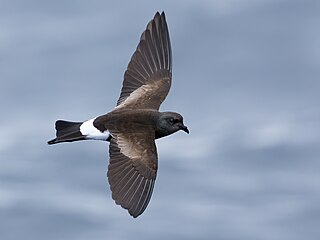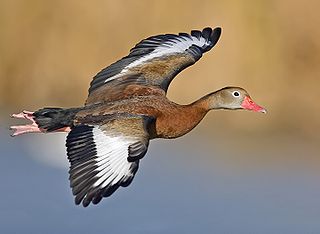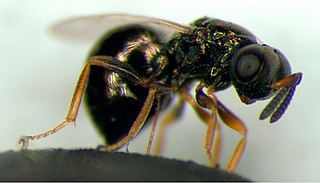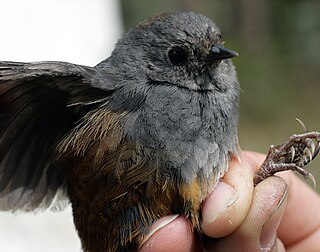
The osprey, historically known as sea hawk, river hawk, and fish hawk, is a diurnal, fish-eating bird of prey with a cosmopolitan range. It is a large raptor, reaching more than 60 cm (24 in) in length and 180 cm (71 in) across the wings. It is brown on the upperparts and predominantly greyish on the head and underparts.

Bird migration is a seasonal movement of birds between breeding and wintering grounds that occurs twice a year. It is typically from north to south or from south to north. Migration is inherently risky, due to predation and mortality.

The blue jay is a passerine bird in the family Corvidae, native to eastern North America. It lives in most of the eastern and central United States; some eastern populations may be migratory. Resident populations are also in Newfoundland, Canada; breeding populations are found across southern Canada. It breeds in both deciduous and coniferous forests, and is common in residential areas. Its coloration is predominantly blue, with a white chest and underparts, and a blue crest; it has a black, U-shaped collar around its neck and a black border behind the crest. Males and females are similar in size and plumage, which does not vary throughout the year. Four subspecies have been recognized.

Chalcid wasps are insects within the superfamily Chalcidoidea, part of the order Hymenoptera. The superfamily contains some 22,500 known species, and an estimated total diversity of more than 500,000 species, meaning the vast majority have yet to be discovered and described. The name "chalcid" is often confused with the name "chalcidid", though the latter refers strictly to one constituent family, the Chalcididae, rather than the superfamily as a whole; accordingly, most recent publications (e.g.,) use the name "chalcidoid" when referring to members of the superfamily.

The mallard or wild duck is a dabbling duck that breeds throughout the temperate and subtropical Americas, Eurasia, and North Africa. It has been introduced to New Zealand, Australia, Peru, Brazil, Uruguay, Argentina, Chile, Colombia, the Falkland Islands, and South Africa. This duck belongs to the subfamily Anatinae of the waterfowl family Anatidae. Males (drakes) have green heads, while the females (hens) have mainly brown-speckled plumage. Both sexes have an area of white-bordered black or iridescent purple or blue feathers called a speculum on their wings; males especially tend to have blue speculum feathers. The mallard is 50–65 cm (20–26 in) long, of which the body makes up around two-thirds the length. The wingspan is 81–98 cm (32–39 in) and the bill is 4.4 to 6.1 cm long. It is often slightly heavier than most other dabbling ducks, weighing 0.7–1.6 kg (1.5–3.5 lb). Mallards live in wetlands, eat water plants and small animals, and are social animals preferring to congregate in groups or flocks of varying sizes.

The red knot or just knot is a medium-sized shorebird which breeds in tundra and the Arctic Cordillera in the far north of Canada, Europe, and Russia. It is a large member of the Calidris sandpipers, second only to the great knot. Six subspecies are recognised.

Wilson's storm petrel, also known as Wilson's petrel, is a small seabird of the austral storm petrel family Oceanitidae. It is one of the most abundant bird species in the world and has a circumpolar distribution mainly in the seas of the southern hemisphere but extending northwards during the summer of the northern hemisphere. The world population was estimated in 2022 as stable at 8 to 20 million birds. In 2010 it had been estimated at 12-30 million. A 1998 book had estimated more than 50 million pairs. The name commemorates the Scottish-American ornithologist Alexander Wilson. The genus name Oceanites refers to the mythical Oceanids, the three thousand daughters of Tethys. The species name is from Latin oceanus, "ocean".

The scarlet tanager is a medium-sized American songbird. Until recently, it was placed in the tanager family (Thraupidae), but it and other members of its genus are now classified as belonging to the cardinal family (Cardinalidae). The species' plumage and vocalizations are similar to other members of the cardinal family, although the Piranga species lacks the thick conical bill that many cardinals possess. The species resides in thick deciduous woodlands and suburbs.

The black-bellied whistling duck, formerly called the black-bellied tree duck, is a whistling duck that before 2000 bred mainly in the southernmost United States, Mexico, and tropical Central to south-central South America. It can be found year-round in much of the United States. It has been recorded in every eastern state and adjacent Canadian province. Since it is one of only two whistling duck species native to North America, it is occasionally just known as the "whistling duck" or "Mexican squealer" in the southern USA.

The American oystercatcher, occasionally called the American pied oystercatcher, is a member of family Haematopodidae. Originally called the "sea pie", it was renamed in 1731 when naturalist Mark Catesby claimed that he had observed the bird eating oysters. The current population of American oystercatchers is estimated to be 43,000. There are estimated to be 1,500 breeding pairs along the Atlantic and Gulf Coasts of the US. The bird is marked by its black and white body and a long, thick orange beak.

Apparent death is a behavior in which animals take on the appearance of being dead. It is an immobile state most often triggered by a predatory attack and can be found in a wide range of animals from insects and crustaceans to mammals, birds, reptiles, amphibians, and fish. Apparent death is separate from the freezing behavior seen in some animals.

The crissal thrasher is a large thrasher found in the Southwestern United States to central Mexico.

The Pteromalidae are a large family of wasps, the majority being parasitoids of other insects. They are found throughout the world in virtually all habitats, and many are important as biological control agents. The oldest known fossil is known from the Early Cretaceous.

Nasonia are a genus of small pteromalid parasitoid wasps that sting and lay eggs in the pupae of various flies. The fly species that Nasonia usually parasitize are primarily blow flies and flesh flies, making Nasonia a useful tool for biocontrol of these pest flies. The small match-head sized wasps are also referred to as jewel wasps based on the emerald sheen of their exoskeleton.

The chestnut-headed tesia is a small insectivorous songbird formerly of the "Old World warbler" family but nowadays placed in the bush warbler family (Cettiidae).

Nasonia vitripennis is one of four known species under the genus Nasonia - small parasitoid wasps that afflict the larvae of parasitic carrion flies such as blowflies and flesh flies, which themselves are parasitic toward nestling birds. It is the best known and most widely studied of the parasitoid wasps, and their study forms a vital part of the information used to describe the order Hymenoptera, along with information from bees and ants. This parasitoid behaviour makes the wasps an interest for the development of biopesticide and biological systems for controlling unwanted insects.
Nasonia longicornis is a species of pteromalid wasp in the family Pteromalidae. It can be identified by the structure of its antennae. It is a parasitoid of Protocalliphora pupae, usually found in birds' nests. The species is found in western North America. Females usually only mate once in their lifetime.
Arsenophonus nasoniae is a species of bacterium which was previously isolated from Nasonia vitripennis, a species of parasitoid wasp. These wasps are generalists which afflict the larvae of parasitic carrion flies such as blowflies, houseflies and flesh flies. A. nasoniae belongs to the phylum Pseudomonadota and family Morganellaceae. The genus Arsenophonus, has a close relationship to the Proteus (bacterium) rather than to that of Salmonella and Escherichia. The genus is composed of gammaproteobacterial, secondary-endosymbionts which are gram-negative. Cells are non-flagellated, non-motile, non-spore forming and form long to highly filamentous rods. Cellular division is exhibited through septation. The name 'Arsenophonus nasoniae gen. nov., sp. nov.' was therefore proposed for the discovered bacterium due to its characteristics and its microbial interaction with N. vitripennis. The type strain of A. nasoniae is Strain SKI4.
Arsenophonus is a genus of Morganellaceae, of the Gammaproteobacteria. Members of the Arsenophonus genus are increasingly discovered bacterial symbionts of arthropods that are estimated to infect over 5% of arthropod species globally and form a variety of relationships with hosts across the mutualism parasitism continuum. Arsenophonus bacteria have been identified in a diversity of insect taxa, including economically important species such as the Western honey bee and the rice pest Nilaparvata lugens.

The Perijá tapaculo is a species of passerine bird in the family Rhinocryptidae (tapaculos). Endemic to the Serranía del Perijá mountain range on the Colombia–Venezuela border, the Perijá tapaculo is found at altitudes of 1,600–3,225 metres. Its body is 10 to 12 centimetres long and its tail is about 4 cm (1.6 in) long. Specimens have long been stored in museums, but the species was described only in 2015 based on sixteen specimens found between July 2008 and February 2009. It is considered vulnerable to extinction.















